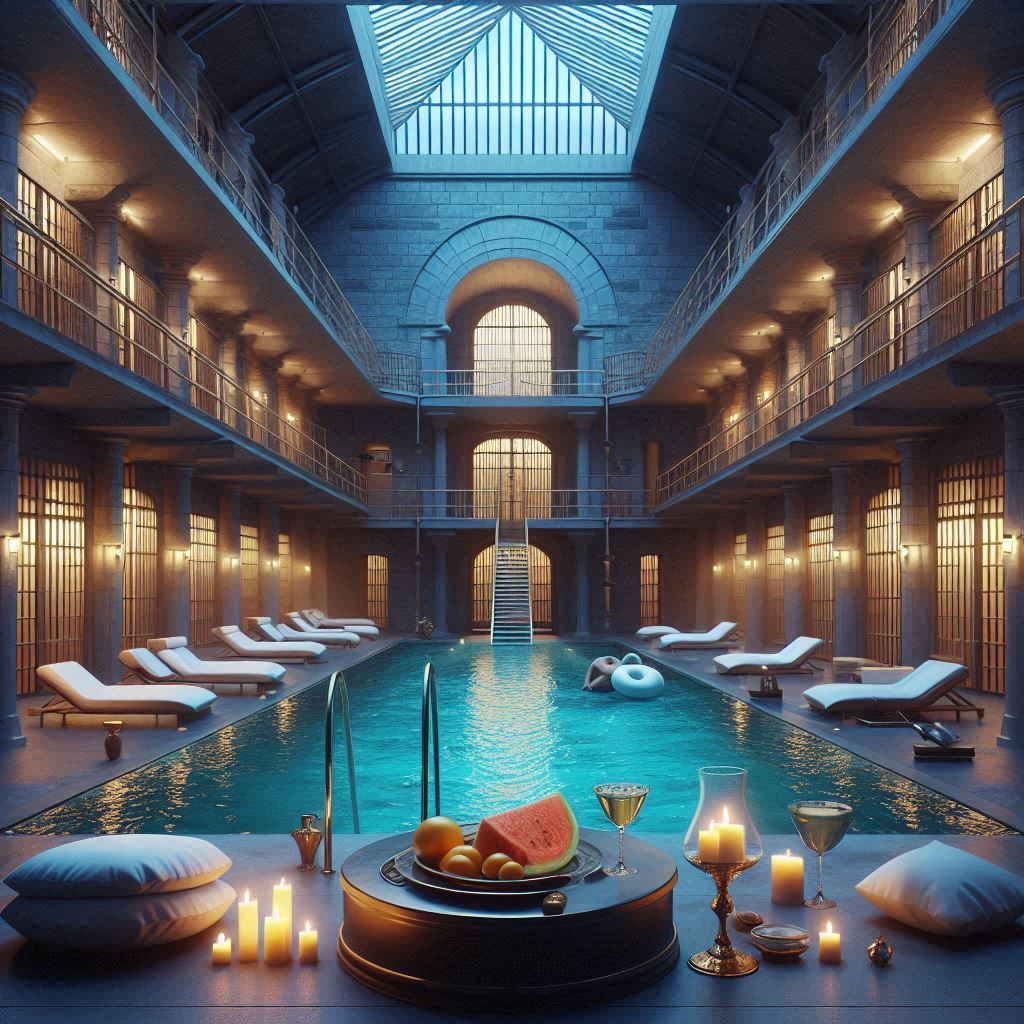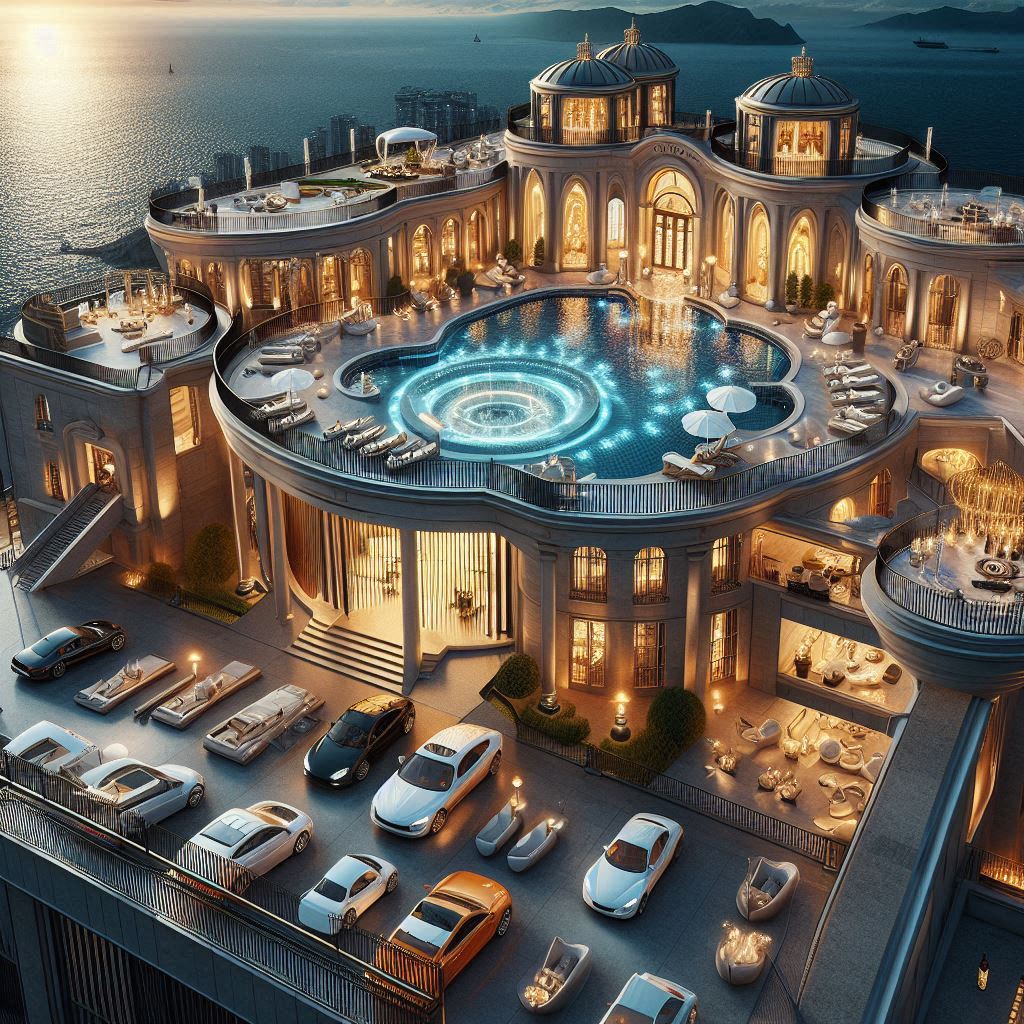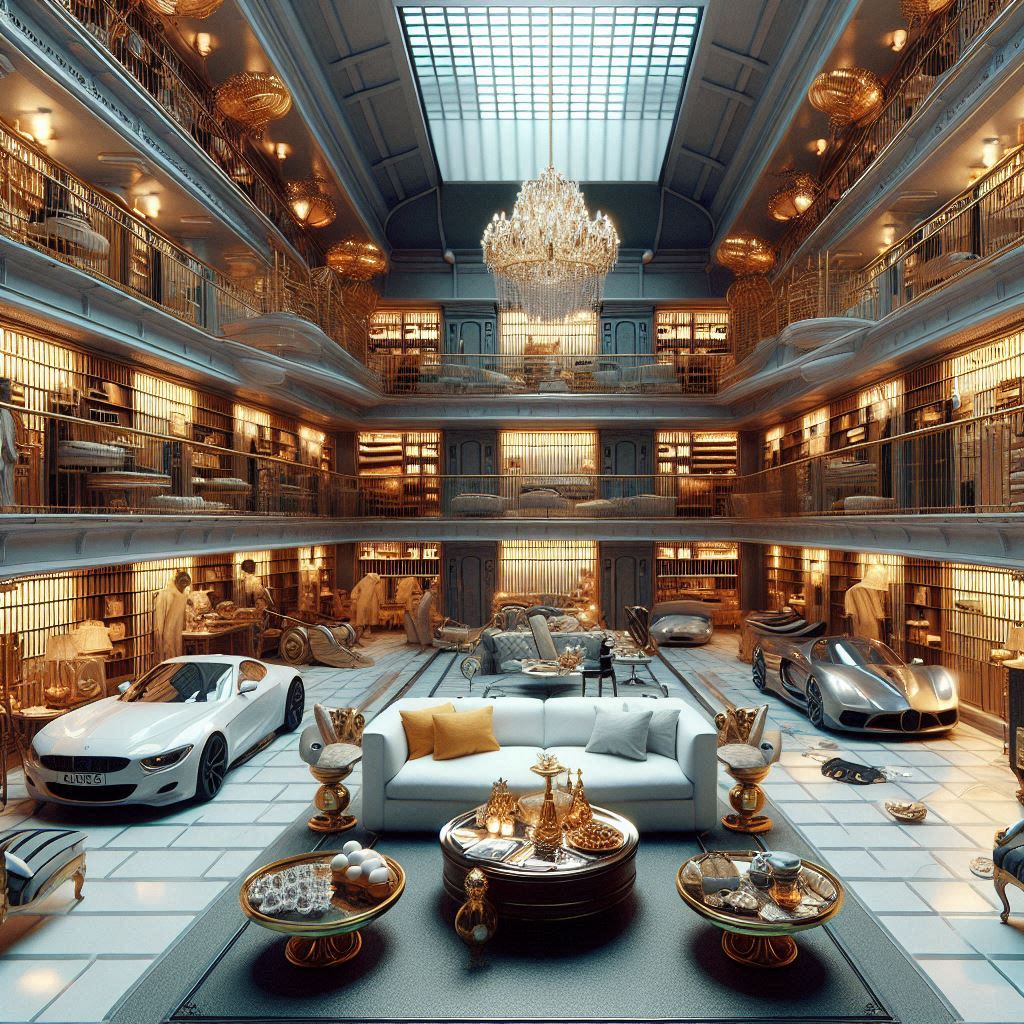
In a world where inequality seems to permeate every aspect of society, it should perhaps come as no surprise that even the prison system is not immune to the influence of wealth and power. Recent revelations have brought to light the existence of so-called “luxury prisons” – facilities that cater to the ultra-rich and powerful, offering amenities and comforts that stand in stark contrast to the conditions faced by the average inmate. This blog post delves into this controversial topic, exploring several examples of luxury prisons around the world and the ethical questions they raise.




The Shocking Discovery in Indonesia
Our journey into the world of luxury prisons begins with a startling revelation from Indonesia. In early 2024, a camera crew stumbled upon a scene that would soon make headlines worldwide. They had discovered that a businesswoman named Arita Suriana had managed to transform her prison cell into what can only be described as a five-star hotel suite.
Arita, who had been convicted of a white-collar crime, was supposed to be serving her sentence in a standard prison cell. However, through a series of bribes to the prison warden and guards, she had turned her damp, grimy cell into a lavish living space that would make many free citizens envious.
The cell, or rather suite, boasted amenities that one would expect to find in a high-end hotel room:
- A flat-screen TV for entertainment
- A king-sized bed for comfortable sleep
- A private bathroom with modern fixtures
- Air conditioning to combat the tropical heat
- Stylish furniture and decor
This discovery sent shockwaves through Indonesian society and beyond, raising questions about the integrity of the prison system and the power of money to influence even the most rigid institutions.
The Art of Bribery: How Arita Pulled It Off
The story of how Arita managed to create her luxurious cell is a testament to the power of money and the weaknesses in the prison system. According to inside sources, Arita’s transformation of her cell was a gradual process that took place over several months.
It began with small bribes to guards for extra food or toiletries. As she built relationships with the staff, the bribes grew larger, and so did the favors. A comfortable mattress here, a private fan there. Eventually, she was able to convince the warden to turn a blind eye to major renovations, including the installation of air conditioning and private plumbing.
The total cost of Arita’s prison makeover was estimated to be in the hundreds of thousands of dollars. This sum, while substantial, was a drop in the bucket compared to the wealth she had amassed through her white-collar crimes.
The Fallout: A System in Question
When news of Arita’s luxury cell broke, it sparked a nationwide debate in Indonesia about corruption in the prison system. The public was outraged, and politicians were quick to call for investigations and reforms.
The warden and several guards were immediately suspended pending a full investigation. However, many criticized these actions as merely scratching the surface of a much deeper problem. Activists and reformers pointed out that Arita’s case, while extreme, was likely not unique. They argued that it was merely the tip of the iceberg, representing a systemic issue of inequality and corruption in the justice system.
A Global Phenomenon
As shocking as Arita Suriana’s case was, it soon became clear that this was not an isolated incident. The camera crew’s investigation uncovered a global phenomenon of luxury accommodations for wealthy inmates. Their research revealed seven of the most opulent prisons catering to the ultra-rich, each more lavish than the last.
The Helicopter Inmate: A New Level of Freedom
Among the most outrageous examples was a prison where one inmate had access to a helicopter, which he used to come and go as he pleased. This level of freedom for a convicted criminal is hard to fathom and raises serious questions about the purpose and effectiveness of incarceration.
The inmate in question was a wealthy businessman convicted of fraud. He had managed to convince the prison authorities that he needed to regularly attend to his business affairs to pay restitution to his victims. Under this guise, he was granted permission to leave the prison grounds by helicopter several times a week.
However, investigations later revealed that many of these trips were for pleasure rather than business. The inmate was spotted at high-end restaurants, exclusive golf courses, and even on a yacht in the Mediterranean. This case highlighted not just the preferential treatment given to wealthy inmates, but also the lack of oversight and accountability in some prison systems.
The Million-Dollar Mural: Art Behind Bars
Another instance that highlighted the extreme disparities in prison conditions was the case of an inmate who spent a staggering $1 million to have a renowned graffiti artist paint murals on the prison walls. While art therapy and beautification projects can have positive effects on inmate rehabilitation, the scale and cost of this project seem more like a display of wealth than a genuine attempt at reform.
The inmate, a former tech mogul serving time for insider trading, argued that the mural project was a gift to the entire prison population, improving the environment for everyone. However, critics pointed out that the money could have been better spent on education programs, mental health services, or improving the basic living conditions for all inmates.
The mural, which covered an entire wing of the prison, depicted scenes of freedom and nature – rolling hills, open skies, and soaring birds. While beautiful, it served as a stark reminder of the freedom that lay just beyond the prison walls, a freedom that wealthy inmates seemed to have greater access to even while incarcerated.
These examples serve to illustrate the vast gulf that exists between the experience of wealthy inmates and those from less privileged backgrounds. While some argue that more comfortable prison conditions can aid in rehabilitation, the level of luxury afforded to these wealthy inmates goes far beyond what could be considered reasonable or fair.
The Bastoy Prison: A Different Approach
Not all unconventional prisons cater exclusively to the wealthy. The Bastoy Prison in Norway presents a fascinating counterpoint to the luxury prisons designed for the ultra-rich. Located on an idyllic island, Bastoy has been described as a “slice of paradise” – a description rarely associated with correctional facilities.
Life on Prison Island
At Bastoy, inmates live in shared apartments rather than cells. They have access to beautiful beaches and are even paid for the work they do within the prison. This approach to incarceration is rooted in a philosophy that emphasizes trust, responsibility, and rehabilitation over punishment.
The physical environment of Bastoy is strikingly different from traditional prisons:
- There are no high walls or barbed wire fences
- Inmates have a significant degree of freedom of movement
- The natural beauty of the island is preserved and accessible to prisoners
Perhaps most surprisingly, inmates at Bastoy are even allowed to leave the island for vacation days. This level of trust and freedom is almost unheard of in most prison systems around the world.
The Philosophy of Trust and Responsibility
The philosophy behind Bastoy is based on three golden rules:
- No violence
- No alcohol
- No drugs
As long as inmates adhere to these rules, they are granted a level of autonomy and dignity that is rare in prison environments. Importantly, Bastoy aims to make this approach available to all qualifying inmates, not just the wealthy. This stands in stark contrast to the luxury prisons we’ve discussed earlier, which explicitly cater to those with financial means.
A Day in the Life at Bastoy
To better understand the unique approach of Bastoy, let’s walk through a typical day for an inmate:
6:30 AM – Wake-up call
7:00 AM – Breakfast in the shared dining area
8:00 AM – Begin work assignments (which could include farming, woodworking, or maintaining the island’s facilities)
12:00 PM – Lunch break
1:00 PM – Continue work assignments
4:00 PM – Free time (inmates can swim, play sports, or engage in various recreational activities)
8:00 PM – Dinner
10:00 PM – Curfew (inmates must return to their living quarters)
Throughout the day, inmates have access to educational programs, counseling services, and vocational training. The goal is to provide them with the skills and mindset needed to successfully reintegrate into society upon release.
The Results Speak for Themselves
The results of Bastoy’s approach are impressive. The prison boasts one of the lowest recidivism rates in the world, with only about 16% of released inmates reoffending within five years, compared to around 43% in the rest of Europe and over 76% in the United States.
While some critics argue that Bastoy is too soft on criminals, supporters contend that its success in reducing recidivism proves its worth. They argue that by treating inmates with respect and providing them with skills and responsibilities, Bastoy better prepares them for successful reintegration into society upon release.
The Cenang Prison: A Tale of Two Worlds
If Bastoy represents an attempt at a more humane and egalitarian approach to incarceration, the Cenang Prison in Indonesia stands as its polar opposite. This facility gained notoriety for providing lavish accommodations exclusively for a single inmate: Tommy Sahar, a billionaire playboy and son of a former Indonesian dictator.
The Prince of Cenang
Tommy’s story is a testament to the power of wealth and connections in corrupting the justice system. Despite being sentenced to 15 years in prison for the grave crime of hiring hitmen to murder a Supreme Court judge, Tommy was allowed to serve his time in conditions that bore little resemblance to a typical prison cell.
Tommy’s accommodations at Cenang included:
- An air-conditioned cell
- A private television
- A picturesque garden view
- Access to a helicopter for personal trips
In stark contrast, the regular inmates at Cenang were forced to endure overcrowded, unsanitary conditions typical of many prisons in developing countries. This juxtaposition within a single facility highlights the extreme disparities that can exist in the treatment of prisoners based on their wealth and social status.
A Life of Luxury Behind Bars
Tommy’s privileged status extended beyond just his living conditions. He was treated more like royalty than a convicted criminal:
- He had access to a three-room cell, a luxury unheard of for most inmates
- His cell was equipped with a 21-inch TV, providing entertainment options unavailable to others
- He enjoyed an expensive, private bathroom, a far cry from the shared, often unsanitary facilities used by other prisoners
- Perhaps most shockingly, he was allowed to use a helicopter to visit his girlfriends, granting him a level of freedom that completely undermines the concept of incarceration
The Other Side of Cenang
While Tommy lived in luxury, the rest of Cenang’s inmates faced a very different reality:
- Overcrowded cells, with up to 20 inmates sharing a space designed for 5
- Limited access to clean water and sanitation facilities
- Inadequate medical care
- Poor quality food, often in insufficient quantities
- Minimal opportunities for education or rehabilitation
This stark contrast within a single facility serves as a microcosm of the larger issues of inequality and corruption in the justice system. It raises serious questions about the nature of punishment and the role of prisons in society.
The case of Tommy Sahar and the Cenang Prison serves as a glaring example of how wealth and connections can subvert the principles of justice and equality before the law. It raises serious questions about the integrity of the prison system and the ability of the ultra-rich to essentially buy their way out of real punishment.
Holden Fangel Prison: Luxury for All?
Moving back to Norway, we encounter another prison that challenges our preconceptions about incarceration. The Holden Fangel Prison has been dubbed the “world’s most humane maximum-security prison,” a title that seems almost paradoxical at first glance.
A New Vision for Incarceration
Unlike the Cenang Prison, which catered to a single wealthy inmate, Holden Fangel aims to provide a high standard of living for all its inmates. The Norwegian government invested a substantial $15 million in building this facility, demonstrating a commitment to a different philosophy of incarceration.
The amenities at Holden Fangel are impressive:
- Private cells for each inmate, promoting privacy and dignity
- Mini-fridges in each cell, allowing inmates some control over their food choices
- Flat-screen TVs, providing access to information and entertainment
- Private bathrooms, a luxury not often associated with prison life
Perhaps most strikingly, the prison features a mural painted by an artist whose work typically commands prices in the millions. This emphasis on aesthetics and culture within a prison environment is part of Norway’s broader approach to incarceration, which focuses on rehabilitation and respect for human rights.
The Philosophy Behind the Design
The design of Holden Fangel is based on the principle of “normality” – the idea that prison life should resemble life outside as much as possible. This philosophy is evident in every aspect of the prison:
- The architecture is designed to maximize natural light and provide views of nature
- Communal areas are furnished like those in a college dormitory
- Inmates are required to work or study, mimicking the structure of life outside prison
- Recreational facilities include a gym, library, and even a recording studio
The goal is to create an environment that prepares inmates for life after prison, rather than institutionalizing them in a way that makes reintegration difficult.
A Different Approach to Staffing
The philosophy extends to the way the prison is staffed and run:
- Guards at Holden Fangel do not carry weapons, fostering a less confrontational atmosphere
- Half of the staff are women, a deliberate choice based on research suggesting this creates a calmer environment
- Guards are required to interact with inmates, eating meals with them and participating in activities
- Staff members are trained in subjects like psychology and human rights, in addition to security protocols
This approach aims to create a more normalized social environment and to build positive relationships between staff and inmates.
The Debate: Punishment vs. Rehabilitation
Critics might argue that such comfortable conditions fail to serve as a deterrent to crime. They question whether a prison that offers amenities many law-abiding citizens lack can truly be considered punishment.
However, supporters of this approach point to Norway’s low recidivism rates as evidence of its effectiveness. By treating inmates with dignity and providing them with skills and education, they argue, prisons like Holden Fangel better prepare inmates for successful reintegration into society upon release.
The debate around Holden Fangel touches on fundamental questions about the purpose of incarceration:
- Is the primary goal to punish offenders or to rehabilitate them?
- Can comfortable conditions coexist with the concept of justice for victims?
- If this approach leads to lower recidivism rates, isn’t that ultimately better for society as a whole?
These are complex questions with no easy answers, but the example of Holden Fangel challenges us to rethink our assumptions about what a prison should be.
La Catedral: A Drug Lord’s Paradise
While some luxury prisons are the result of systemic corruption or progressive social policies, others are born from the raw power of criminal enterprises. Perhaps no example illustrates this better than La Catedral, a prison in Colombia that was effectively built and controlled by the infamous drug lord Pablo Escobar.
The Deal of the Century
In the early 1990s, Escobar, facing increasing pressure from law enforcement, struck a deal with the Colombian government. He would surrender and serve time, but only in a prison of his own design. The result was La Catedral, a facility that bore little resemblance to a traditional prison:
- The “prison” included a full kitchen, allowing Escobar to enjoy gourmet meals
- A gym was available for Escobar and his men to stay in shape
- A disco provided entertainment, complete with music and dancing
- Perhaps most extravagantly, Escobar’s personal quarters featured a rotating bed, a symbol of his continued lifestyle of excess
La Catedral was less a place of confinement and more a fortified luxury resort. Escobar continued to run his criminal empire from within its walls, hosting lavish parties and entertaining guests. The guards, who were on Escobar’s payroll, did little to restrict his activities.
Life at La Catedral
A typical day for Escobar at La Catedral was far from what one might expect of prison life:
- Mornings might start with a swim in the private pool, followed by a gourmet breakfast
- Business meetings would be conducted throughout the day, with Escobar continuing to oversee his vast criminal network
- Afternoons could involve soccer games on the prison’s full-sized field, often with professional players brought in for Escobar’s entertainment
- Evenings might include lavish dinners with family and friends, followed by parties in the disco
All of this occurred under the guise of incarceration, with the Colombian government seemingly powerless to intervene.
The Fall of La Catedral
This arrangement lasted until the Colombian government, under increasing international pressure, attempted to move Escobar to a more secure facility. In response, Escobar simply walked out of La Catedral, evading authorities for months before his eventual demise.
The case of La Catedral represents an extreme example of






